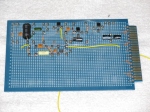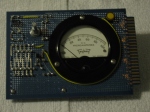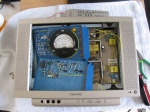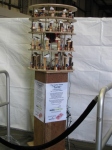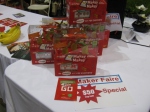Archive for the ‘Maker Faire’ Tag
It was great to see the announcement of a new Maker Faire event in Orange County, Calif. after so many years. Organizing and launching a new event is a ton of work, thank you to all planners, sponsors and the volunteers to make this happen!
I am glad all of my Maker Faire projects are still intact and have not been hacked for parts or made into other projects. So I brought some of my favorite projects from past events. This had to be done, since I had a short notice of the event.
I answered many questions on the items on display, and so I decided to share some details of what I did to these projects to make them “Maker Faire friendly.”
And, as part of our theme – Not Your Grandpa’s Ham Radio – all projects – as one visitor said, “do not look anything like the radios I have seen.”
My team of ham radio operators are always inspired to explore, experiment, improve, and create new and fun gadgets with some radio related twist. Integrating, hacking, modifying, breaking and fixing are all part of the ham radio experience. This is a ham radio tradition over 100 years old – and continues. Our mission is to explain and expose people to today’s ham radio and the technologies we use. It is truly “not your grandpa’s ham radio.”
Projects on Display – Details
Transverter System for the 10368 MHz (10.368 GHz) Amateur Radio Band


My current transverter system is based on a kit from Kuhne Electronic, in Germany. It is an older unit, their website has a new and improved version.
I said “current” system because the rig has changed many times over the years, which is why my transverter is named “Morpheus.”
In Greek mythology, Morpheus is the god of sleep. However, My use of the name is derived from the many iterations of the basic components, layout/ergonomics, performance and packaging. In other words, it has “morphed” or changed many times.
By the way, the transverter is only one part or module of a working 10 GHz ham radio transverter station. The transverter must be interfaced with other sub-assemblies in order to actually communicate.
I covered this aspect in several articles, here are some articles available online:
QSO Today Online Expo August 8, 2020: More 10 GHz Information
Presentation: Microwaves: Not Just for Leftovers
Lightning Detector Circuit from Charles Wenzel’s TechLib (Technical Library)

Lightning Detector/300 kHz Receiver
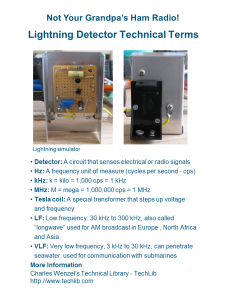
As mentioned during the show, the lightning detector is a very low frequency (VLF) receiver. The circuit can be found on Charles Wenzel’s site, TechLib, short for “Technical Library.”
My lightning detector appeared in Makezine, “Detect Lightning with a Simple Circuit”
My Lightning Detector at Bay Area Maker Faire 2016 can be seen in this LinkedIn post.
The LASER Communicator

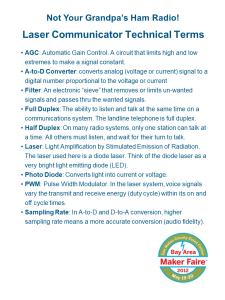
Ramsey Electronics Model No. LBC6K. No longer made but may be available on online auction sites or other sources.
The RF Signal Detector

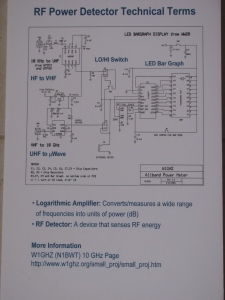
The RF detector is based on a portable power meter available as a kit from Down East Microwave (DEMI). It is called the W1GHz All Band Power Meter Complete Kit, Model ABPM. I replaced the LED bar graph display with individual LEDs to make the “meter” more visible.
The 1152 Board: The Magic Frequency


The 1152 MHz synthesizer is a modified circuit board from a surplus Qualcomm electronic logging device (ELD) for freight trucks. Modification information can be found on the San Bernardino Microwave Society (SBMS) website.
More about me
QSO Today Podcast
Ham Radio Workbench
Not Your Grandpa’s Ham Radio 2016

Update
Not Your Grandpa’s Ham Radio Wins ‘Best in Class’ Ribbon
Maker Faire Bay Area was extra-special for us this year: We won a ribbon for “Best in Class.”
Maker Faire Hq. explains there are two ribbon categories: a blue ribbon for best in show, and a red ribbon for best in class. The red ribbons are also used to show the Maker has an educational element.
This red ribbon is an excellent victory, because the Maker Faire staff recognizes for our mission statement:
To show people what today’s ham radio operators are doing with the newest technology, and to change the image of ham radio, making it both contemporary and chic in a hi-tech way. We also want to emphasize how ham radio can be used for science and technology education and a possible career path for youngsters.
Our projects demonstrate how ham radio technology changes with the times, yet still includes both past and present to accomplish one thing: Creating ways to communicate voice and data over the ether, without wires.
Maker Faire Hq. keeps track of Makers as they (we) win ribbons.
Notice several Makers have multiple ribbons. Now we have an additional Maker Faire goal: We need to win a ribbon each year.
Maker Faire Bay Area Team 2016
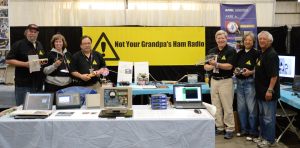
Left to right: Dennis Kidder W6DQ, Lisa Gibbons KF6QNG, Wayne Yoshida KH6WZ, Marty Woll N6VI, Patricia Yee, Brian Yee W6BY. Not pictured: Joel Wilhite KD6W, Victor Frank K6FV and Paul Zander AA6PZ. The new polo shirts made by Dennis gave booth staff a professional look. Photo by Dennis Kidder.
A Setup Day Tradition and Treat – Gerard’s Paella

Hungry Makers ready for paella and various beverages after setting up their displays and activities.
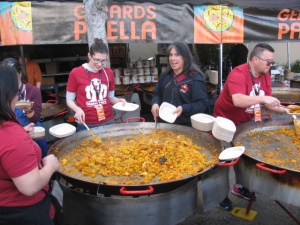
Volunteers scoop and serve paella to the Makers after Maker Faire Bay Area setup day.
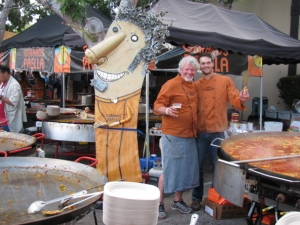
Gerard and his nephew Tom as the paella feast winds down.
This is a tradition at the Maker Faire Bay Area: Gerard’s Paella. Gerard Nebesky trucks in his crew and giant paella pans, which are about 20 feet in diameter. Gerard feeds over 2500 hungry Makers on Friday evening. A great big Thank You goes out to Gerard and his Maker Faire crew!
Here’s a quick video of the paella feast at the 2014 Bay Area Maker Faire.
New Projects
Lightning Detector, Low Frequency (300 kHz) Receiver
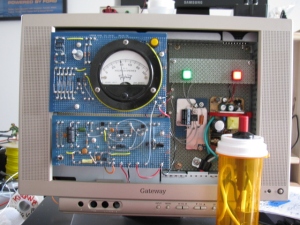
The completed lightning detector-300 kHz receiver completed a few nights before the Maker Faire. On the right is the “lightning simulator” – a piezo BBQ striker in a plastic pill bottle.
The lightning detector-300 kHz receiver is built into a broken LCD TV cabinet. Originally, I thought I could re-use the power supply, infrared remote control and audio amplifier. Unfortunately, the TV is built with a small number of ICs with multiple functions. The power supply performed strangely when I probed around to map out the output voltages. Since I was on a tight schedule, I gutted the unit, and kept only the speakers.
Lightning flashes and Tesla coils generate a wide range of radio frequencies near 300 kHz, slightly below the AM broadcast band (540 kHz to 1700 kHz). The electrical impulses can be perceived as “noise” or “static” in a radio receiver.
The Lightning Detector is a “resonant tank circuit” which detects the electrical impulses, amplifies them so the noise can be heard on a speaker, seen on the yellow LED and moves the needle on the meter.
A lightning simulator is used to test or demonstrate the unit in action when no storms are in the area. It is a low frequency, low level oscillator. Another way to simulate lightning is to use a piezo electric striker, like the ones used in some cigarette lighters and gas barbecue starters.
Information on this circuit comes from Charles Wenzel’s Technical Library (TechLib). There are a lot of interesting projects and includes a gallery of readers’ projects.
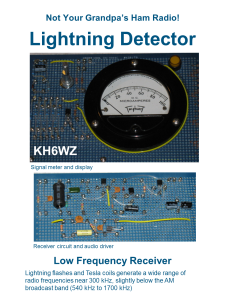

A Software Defined Radio – Made with Vacuum Tubes
A what made with what?
This is an interesting mix of old and new. Dennis Kidder, W6DQ, came up with this idea. Vacuum tubes are fully capable of performing many of the same functions as modern solid-state devices.
Dennis says, “The best part of using tubes in a project — they look really cool!”


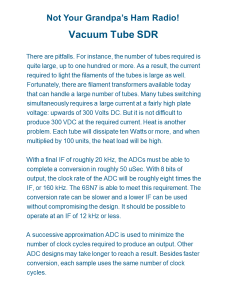
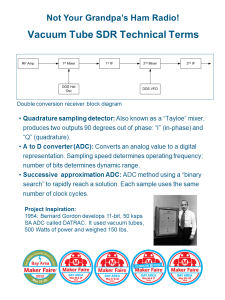
24 GHz Beacon

Brian Yee, W6BY, brought his Amateur radio beacon. A beacon is a one-way radio transmitters usually used as “propagation indicator” to help see how signals are traveling through the air. They can also be used as a signal source or reference to measure frequency, calibrate radio receivers and test antennas. Brian’s beacon operates on the 24 GHz band, and is made with modified microwave telecommunications sub-assemblies. An Arduino Nano is used as the beacon identifier. It sends out Brian’s ham radio callsign W6BY every 10 minutes (an FCC requirement) as well as a series of tones to help locate and identify the beacon.
N6VI Antenna and Spectrum Analyzer Demonstration
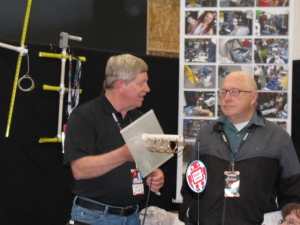
Marty Woll brought a portable spectrum analyzer and an assortment of hand-built antennas, including this corkscrew (circular polarized) antenna. A weak signal source was placed at the far end of the booth. By moving the antenna around, the spectrum analyzer shows frequency and signal strength. This can visually demonstrate antenna polarization and direction as well as frequency and harmonics.
KH6WZ 10 GHz Transmitter-Receiver System
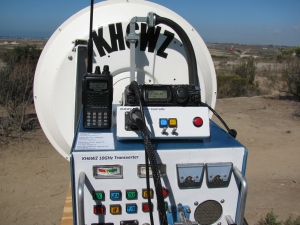
The “anchor project” from past events is my 10 GHz transverter system. This station is used to demonstrate and explain frequency multiplication and division, frequency up-conversion (transmitting), down-conversion (receiving), polarization and antenna directivity to non-hams and even children.
W6DQ Software Defined Radio (SDR) Demonstration
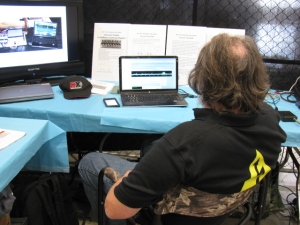
Dennis Kidder W6DQ, displayed his software defined radio (SDR). There were many questions about SDRs and many visitors were surprised to learn ham radio operators have this technology. But this is another example of what radio hams are using these days.
Virtual Air Traffic Control Receiving Station Using ADS-B – Automatic Dependent Surveillance – Broadcast

ADS-B is the “next generation” air traffic control, to replace/supplement ground-based radar. Each aircraft transmits identification, GPS position, flight information and other data.
It is very easy to make an ADS-B receiving station. Here are the things needed:
- A digital TV (DVB-T) dongle – DVB-T is Digital Video Broadcast – Terrestrial, a digital TV standard used in Europe and other, non-North American locations
- Antenna for 1090 MHz, this can be built with cable TV coaxial cable and a few other items.
- Windows PC
- ADSB# (ADSB Sharp), a free application
- Virtual Radar Server, another free application
- Browser and Internet Connection
An inexpensive (less than $20 US) digital TV software defined radio in a USB dongle is used to decode ADS-B signals. Free downloadable applications for Windows PCs are used to decode and display the live air traffic broadcasts on a computer.
There is one important thing to know when buying your DVB-T dongle: The decoder and display programs work only with dongles using the Realtek RTL2832U with the RaefaelMicro R820T Tuner chip set.
More ADS-B Receiver Information
“Virtual Radar from a Digital TV Dongle,” QST, January 2014
ADSB# (SDR Sharp) – Download
Virtual Radar Server – Download
Broadband-Hamnet™ (formerly called HSMM-Mesh™) Demo

Dennis W6DQ (seated) assembling the BBHN network demo as Marty N6VI asks a few questions about the network.
Broadband Hamnet (BBHN) re-purposes commercial Wi-Fi equipment to operate only in the ham bands to create robust, wireless, IP-based networks suitable for emergency communications or remote monitoring and control.
Commercial Wi-Fi equipment is restricted through FCC Part 15 regulations, limiting power and range and precluding the user from modifying type-accepted products.
However, licensed ham radio operators are legally allowed to modify Part 15 devices to make them operate in the FCC Part 97 rules for ham radio operation. Larger antennas, higher power, adding receiver pre-amplifiers and other techniques are allowed for experimentation.
The result is a system which creates an ad-hoc, meshed network, supporting IP traffic, e.g., voice, video and data. A meshed wireless network affords greater reliability by providing alternative route paths in the event of a failure.

Dennis says there sure a lot of wires needed for wireless networking.
Note: There are two systems for amateur radio wireless networking – Broadband HamNet (BBHN) and Amateur Radio Emergency Data Network (AREDN). If you are interested in experimenting with this, check with others in your area to see what they are using.
10 GHz / 24 GHz Dual Transmitter-Receiver System

Joel Wilhite KD6W constructed a 10 GHz and 24 GHz dual-band transverter system for portable use. It consists of various modified modules from several sources.
We encourage kids and parents to talk to each other using our home-built radios. It helps make things more interesting than just looking at things.
UPDATE — See what Dennis W6DQ and I did for the San Diego Maker Faire!
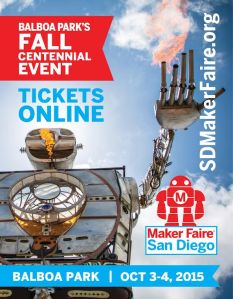
This is our fourth consecutive year as Makers. The 2015 SD Maker Faire team is Dennis W6DQ and Wayne KH6WZ.
Our mission is to change the image of ham radio, making it both contemporary and chic in a hi-tech sort of way. We also want to emphasize how ham radio can be used for science and technology education and a possible career path for youngsters.
Amateur, or ham radio has always included teaching-learning-making-modifying-hacking and networking (making new friends) traditions for over a hundred years. We want to remind people this “new Maker Movement” is not really a new idea. Read my LinkedIn Publish post called “The Original Makers” to learn more about this.
We also want to show everyone that ham radio technology changes with the times, and continues to include both past and present to accomplish one thing: Creating ways to communicate voice and data over the ether, without wires.
Here are some of the projects on display – stay tuned for more stories and pictures after the event!
-

-
Live virtual air traffic control radar receiving station
-

-
Homemade antenna
-
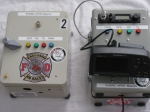
-
APRS / location tracker demonstration
-
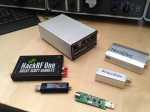
-
Software defined radio modules. Photo by Dennis Kidder, W6DQ
-
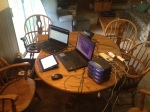
-
Broadband ham radio network under construction
By the way – here are 65 reasons why ham radio continues to survive – and possibly thrive – in a world of instant, global communication fro everyone:
65 Great Things About Ham Radio
CQ magazine celebrates its 65th anniversary by making a list of 65 great things about ham radio. Ham radio can be considered one of the earliest forms of “social media,” “networking” and “making.” Items in italics can be considered “life lessons.”
1. It works when nothing else does
2. It makes you part of a worldwide community
3. The opportunity to help neighbors by providing public service and emergency communications
4. Some of the nicest people you’ll ever meet
5. Some of the smartest people you’ll ever meet
6. Some of the most interesting people you’ll ever meet
7. Some of the most generous people you’ll ever meet (along with some of the cheapest!)
8. Lifelong friendships
9. Friends around the world (including those you haven’t met yet)
10. The opportunity to go interesting places you might not otherwise go to
11. The opportunity to do interesting things you might not otherwise get to do
12. The opportunity to expand your knowledge of geography
13. The opportunity to expand your knowledge of earth and space science
14. Practical uses for high school math
15. Practical uses for high school physics
16. A good way to practice a foreign language
17. A good way to keep in touch with faraway friends and relatives
18. A good way to get driving directions when visiting someplace new (with or without GPS)
19. A good way to find the best places to eat when visiting someplace new (with or without GPS)
20. Finding “non-touristy” off-the-beaten-path places to stay, eat, visit, etc.
21. A good way to learn about virtually any topic
22. A good way to bridge the generation gap
23. A good way to keep tabs on elderly/infirm people
24. People named Joe (Walsh, Rudi, Taylor)
25. How many of your non-ham friends have actually talked to someone in some remote place such as Cape Verde or the Seychelles?
26. How many of your non-ham friends might have talked to an astronaut aboard the space station?
27. How many of your non-ham neighbors might have a satellite uplink station in their basements—or in the palms of their hands?
28. How many of your non-ham neighbors might have a TV studio in their garage?
29. What other hobby group has designed, built, and had launched its own fleet of communication satellites?
30. Where else can you play with meteors?
31. Moonbounce
32. Informal way to improve technical skills
33. Informal way to improve communication skills
34. Introduces a variety of career paths
35. Offers unparalleled opportunities for career networking
36. Opportunities for competition in contesting and foxhunting
37. A good way to collect really cool postcards from around the world (despite the growth of electronic confirmations)
38. Nearly endless variety of different things to do, on and off the air
39. Hamfests
40. Dayton
41. Field Day
42. Working DX
43. Being DX
44. DXpeditions
45. Contesting
46. Award-chasing
47. Double-hop sporadic-E
48. Worldwide DX on 6 meters (once or twice every 11 years) [The current extended sunspot minimum has shown that mechanisms other than F2 propagation can offer intercontinental DX on the “magic band” at any point in the solar cycle.]
49. Tropospheric ducting
50. Gray-line propagation
51. TEP, chordal hops, etc.
52. Getting through on CW when nothing else will
53. Unexpected band openings
54. Building your own gear
55. Using gear you’ve built yourself
56. Operating QRP from some remote location
57. Experimenting with antennas
58. Working DX while mobile or while hiking
59. Experimenting with new modes and new technology
60. The opportunity to help build an internet that doesn’t rely on the internet
61. DXing on your HT via IRLP and Echolink
62. Contributing to scientific knowledge about propagation
63. Keeping track of other people’s GPS units via APRS
64. Ham radio balloon launches to the edge of space, and as always…
65. Reading CQ!
Take a look at the CQ magazine website to find more interesting things about ham radio.
32.715738
-117.161084
October 3 and 4: Maker Faire® San Diego!

Maker Faire San Diego is October 3 and 4, 2015, from 10 AM to 6 PM at Balboa Park. Our “Not Your Grandpa’s Ham Radio” theme will feature some new projects as well as some of the old, but popular demonstrations from previous Maker Faire events. Pictured below is a project under construction, I hope to have it completed for this event. It is a homemade 1090 MHz collinear (vertical) antenna that will be part of an air traffic control monitoring station using a software defined radio (SDR).

October 15 to 18: Microwave Update (MUD)!
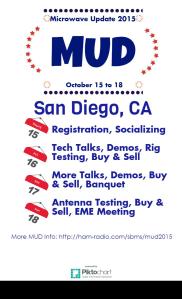
Microwave Update, or MUD, is a yearly technical conference for amateur radio experimenters making, modifying, hacking, building, testing and using the 1,000 MHz and up radio bands. Participants from all over the world gather at these events to share information about operating techniques, radio propagation and radio station equipment. One aspect of this event is the buying, selling and trading of surplus parts and assemblies for these frequency bands, since some items may be difficult to procure in some areas. But perhaps the best thing about MUD is socializing and making new friends from all over the world to discuss common interests and goals.
Preparations for the San Diego MUD are still under way. Last weekend, a few San Bernardino Microwave Society (SBMS) members gathered at Dave’s lab to sort and package some prize and give-away items for the event.

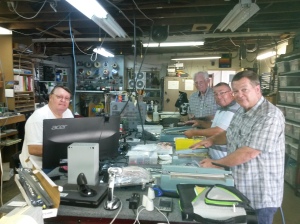
Left to right: Dave WA6CGR, Rein W6SZ, Pat N6RMJ and Jim KK6MXP sorting and packing some microwave frequency prizes and give-ways.
I hope to see you at any or both of these events!
Since pictures are worth a thousand words, here is a 2015 Bay Area Maker Faire recap in images from and around our Not Your Grandpa’s Ham Radio theme booth.
Click here to see the official Bay Area Maker Faire video from 2015
The Bay Area Maker Faire 2015 team: Team Leader Brian Yee W6BY and his wife Pat and daughter Stephanie, Dennis Kidder W6DQ, Lisa Gibbons KF6QNG and Paul Zander AA6PZ
We had working, hands-on ham radio projects including Brian’s (W6BY) 10 GHz ham radio transverter system, a radio-controlled tractor/forklift (ZigBee controller) and the big screen used as an electronic sign.
Dennis W6DQ brought several brand new projects this year, including a working Amateur Radio broadband (WiFi) network with seven nodes, a software-defined radio (SDR) system.
I brought a demonstration comparing old and new technology in antenna tuners. It uses light bulbs for a substitute (“dummy”) antenna.
-

-

-

-

-
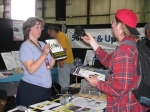
-
Lisa showing the new Arduino book to an interested Maker
-
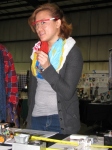
-
Stephanie shows off her “Lear to Solder” badge of honor
-

-
Guys at the Nepal ham radio booth
-

-

There’s so much to see and do. Here are some pictures of what I get a chance to see.
Always great to see Tenaya promoting Arduino and Arduino related projects and products!

Great shirts and signage – Only at the Maker Faire!
Here are the posters we used to describe our projects on display this year.















Maker Faire Bay Area 2015 T-Shirts for Makers
Maker Faire Bay Area is now history. Our booth, “Not Your Grandpa’s Ham Radio” included new projects and demonstrations. This was our fourth year as Makers and the fifth year as visitors to the Maker Faire in San Mateo.
This is a short overview of our display. Stay tuned for more images, stories and videos.
Here is the text from our handout. It answers some of our most-often asked questions:
What are we doing?
Thank you for your interest in our Maker Faire display “Not Your Grandpa’s Ham Radio.” This is our fourth consecutive year as “Makers,” and our goal is to show people what today’s ham radio operators are doing with the newest technology.
Who are we?
We are licensed Amateur radio operators (“hams”).
Is this like CB?
Yes and no. Ham radio is similar in that we use two-way radios and antennas to talk with each other, but hams can communicate using Morse code and computers in addition to voice, and we even have our own satellites. Ham radio requires a license issued by the Federal Communications Commission (FCC) in the US and licensees are required to pass a written test on electronics theory, radio regulations and operating procedures.
How far can you talk?
We can communicate with other ham stations around the corner or across the globe, depending on a variety of factors that affect the way radio waves travel. The equipment we are using operates on frequencies that generally follow line-of-sight paths. However, hams have discovered that signals can be reflected against objects such as buildings, trees, islands and mountains to extend the range. Using these techniques, we are able to contact other stations hundreds of miles away.
What kind of radios are you using?
We are builders and experimenters in microwave radio communications. No commercially-built, “off-the-shelf” equipment for these frequencies exists, so we must build our own equipment, or modify commercially-made equipment meant for other communications services, such as satellite TV, cell phone and long-distance telephone.
How much does this equipment cost?
Like any other hobby, people spend as much or as little as they can afford. Most people involved in ham radio spend as much as any serious stereo enthusiast, amateur photographer or woodworker.
Where can I get more information?
American Radio Relay League (ARRL) and QST Magazine
CQ Magazine
If you are a licensed ham and want to try a new challenge, contact your local VHF and up club:
The 50 MHz and Up Group
The San Bernardino Microwave Society (SBMS)
The Microwave Group of San Diego
Wayne Yoshida KH6WZ: YouTube
Broadband Hamnet-REV2

Broadband Ham Radio Network Under Construction. Photo by Dennis Kidder W6DQ
Software Defined Radio

Elements for the SDR. Photo by Dennis Kidder W6DQ
Old-vsNew-Ant-tuners

Old vs New Antenna Tuner Technology
KH6WZ 10GHz rig-Poster

Microwave transverter system by Brian Yee W6BY. Photo by Brian Yee W6BY
APRS Poster

APRS demonstration

The Greeter

The Maker Faire Team from the San Bernardino Microwave Society (SBMS) and the 50 MHz and Up Group is once again displaying their newest projects at the Bay Area Maker Faire.
We are “Not Your Grandpa’s Ham Radio” – Maker Number 50122
-

-

-
Maker Faire – Where it’s Cool to be Smart
-

-

-
Photo by Kyle Cothern of CrashSpace
-

-

-
The Electric Giraffe at Maker Faire
Maker Faire headquarters announced early bird discounts for Maker Faire Bay Area on May 16 and 17, 2015.
What’s Maker Faire? Take a look at this Drone’s Camera View from Bay Area Maker Faire 2014.
The sale ends on February 28, so don’t delay!
Order your tickets now to take advantage of the discount.
I will see you there – Look for “Not Your Grandpa’s Ham Radio” and our new projects!

Paella is a delicious rice dish. There was a reference to paella on a Seinfeld episode. I have eaten lots of paella, but never made it. So, after several Maker Faire events in the Bay Area, I really wanted to try making my own.
Based on a recommendation from a fellow Big Green Egg fan (Thanks Dale!), I bought a paella pan made in Spain and Bomba rice from La Española Meats, Inc. in Harbor City, CA.
My 15-inch pan would be perfect for my Large Big Green Egg – except for the handles. They are too big and prevent the pan from sitting on the grill grate. I think I can bend the handles so it will fit the 19-inch grate on the BGE. I didn’t let this glitch stop me. I inverted the grill basket used for the vegetables, and put the paella pan on top. If you look closely at the pictures, you can see the basket under the paella pan. Seemed to work OK.
Of course, my paella pan is not as big as the giant ones used by Gerard’s Paella at the Maker Faire, but my pan is large enough to make 8 servings.
I used Steven Raichlen’s recipe from Primal Grill, Season One as a starter. (“Paella Primavera (with Vegetables and Beans But No Meat.”) His version is vegetarian, using all roasted veggies and vegetable broth. I had some Portuguese sausage in my freezer, and chicken stock, so I used them in my first attempt.
Here are the grilled veggies – Onions, garlic, red and green bell peppers, tomatoes, zucchini squash. These were direct-grilled in a basket. I used extra virgin olive oil and tossed on some sea salt, oregano, black pepper and basil.

Next, I direct-grilled the sausages in the basket. These were Hoffy brand Portuguese sausages. I wasn’t too pleased with this sausage. It was not bad, it was just a little too plain and mild for me. I still have several other brands of Portuguese sausages from Hawaii in my freezer. I need to test those soon.

I heated up the paella pan and added some olive oil. This is the chopped onion, garlic, peppers, saffron and chicken broth. . .

After several minutes, I added the Bomba rice. . . .

I almost panicked as the broth dried up – the rice was not fully cooked, and I was afraid of scorching the pan and ruining the dish. But, I quickly added some chicken bouillon to add more liquid. I had to add a total of four additional cups of liquid to get the rice just right. This is a total of 10 cups of broth. Not sure why this is so much more than Raichlen’s version. I do not recall how long I cooked this dish – I just cooked until the rice was tender.
Here is the dish with all the liquid absorbed. Bomba rice is nice and tender, and very tasty. Bu wait – there’s more. . .

Next, I added the grilled vegetables and the sausage. . .

This would be a great one-pan party dish for a good sized and hungry group.















